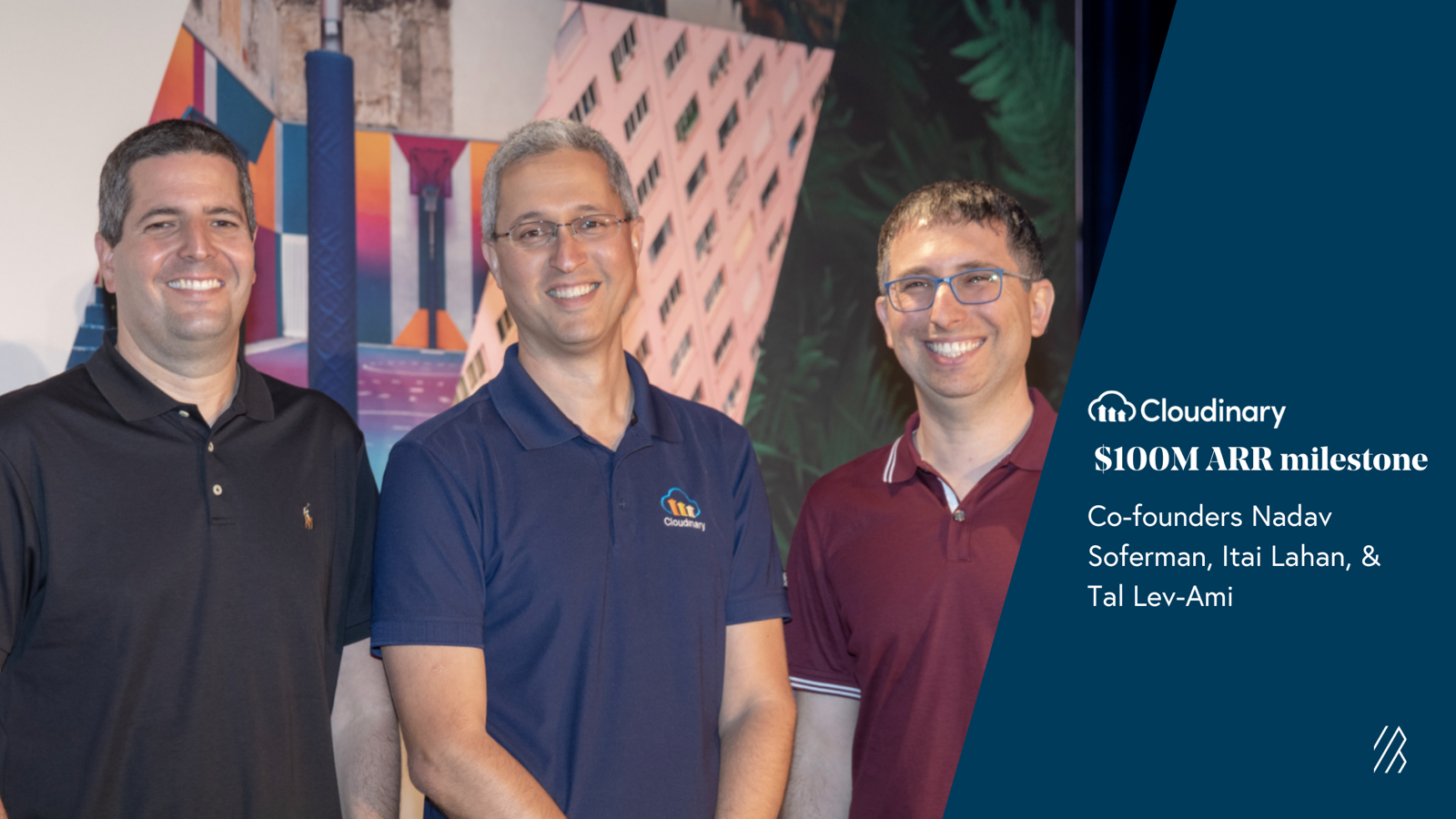Bootstrapping to $100 million ARR: Cloudinary
Lessons on how audacious builders can grow and scale without VC dollars—and what the Cloudinary story illustrates for founders of different stripes.
The term “bootstrapping” applies to founders who steer clear of venture dollars, skip the seed stage, and find alternative means of financing their product development and initial sales, which include side gigs, consulting, credit card debt, and custom development. But startups that enjoy initial success bootstrapping eventually encounter the far more costly challenge of scaling customer growth and simultaneously pursuing new product development without external funding. Raising money at this stage—typically when revenues reach around $5 million—can hardly be considered surrender as the founders will likely retain control of their company for the foreseeable future having skipped the most dilutive financing stages of a startup’s life.
The wholly bootstrapped startup has become a true mythical creature.
But with access to venture capital both plentiful and inexpensive in recent years, the wholly bootstrapped startup has become a true mythical creature. Names such as Atlassian, Mailchimp, and Zoho come to mind in the bootstrapped Hall of Fame, and now Cloudinary is one of them, too.
Cloudinary belongs to an extremely small group of cloud startups that managed to hit the $100 million ARR milestone without ever raising a dollar of equity. Valued at $2 billion based on its most recent secondary transaction, Cloudinary stands out among its venture-backed unicorn peers; they demonstrate how cloud businesses can choose a middle path between the anti-investor bootstrappers and the classic VC-backed founders. Such an approach to secondaries has proven great for employees, while preserving founder autonomy and latitude.
For the Cloudinary founders—Itai Lahan, Nadav Soferman, and Tal Lev-Ami—bootstrapping wasn’t a plan or philosophy, but a result of a fortunate set of circumstances that allowed them to start and remain bootstrapped through today. And as they will attest, how and why they did it isn’t very instructive for fellow entrepreneurs, but some lessons are still appropriate for the current environment of efficient company building. As the first and largest institutional shareholder of Cloudinary via multiple secondary purchases, we’ve gleaned some unique insights into the advantages that are gained from remaining, for lack of a better word, “bootstrapped.” And for the founders who have taken VC dollars, the lessons can be enlightening.
Fundamentals to bootstrapped success
Most bootstrapped startups that successfully reached the growth stage leveraged a “freemium” model to sell products that have powerful network effects that drive down customer acquisition costs (e.g. SurveyMonkey, Qualtrics, MailChimp, TeamViewer). But lacking powerful, compounding network effects, most bootstrapped startups ultimately abandon the self-funded path and tap venture capital for continued scale. For instance, Shopify, Squarespace, and GitHub each leveraged freemium models to attain impressive revenue momentum, but each eventually sought outside investment to help with the next stage of growth.
Occasionally, however, the freemium model also facilitates a word-of-mouth distribution channel that endures and deepens with time creating an insurmountable competitive moat. Two notable examples here are Atlassian and Cloudinary, and it’s no coincidence that both target the developer community. We think freemium companies that target a community of customers have a higher likelihood of achieving market dominance without expensive sales and marketing operations.
Because bootstrapped companies have to live within their means they must operate based on sustainable SaaS KPIs including high gross margins, a fast payback on CAC, and healthy cohorts. This often puts them in a disadvantage to startups that use venture capital to fund growth with ever growing losses. It's an unfair battle in some sense, but the bootstrapped company gains certain things from their efficiency that cannot be bought with venture dollars, including focus, alignment with employees and less exposure to changes in market conditions or investor sentiment.
Cloudinary’s beginnings
The company we know as Cloudinary emerged as a result of development work the founding team was doing with a handful of customers. Noticing the repetitive development work involved in setting up an image management system, they acquired domain know-how and expertise required to develop an API-based product for developers. The low-cost scaling of Cloudinary’s business stemmed from a strategic decision to provide a generous free offering across use cases and customer size. This decision created an extremely high bar for the competition that would continually grow, making developers around the world enamored with the Cloudinary offering. The final strategic decision was a usage-based pricing model that gave rise to strong customer cohorts with net negative revenue retention (NRR). Like many of the aforementioned companies, Cloudinary practiced and mastered product-led growth (PLG) before that acronym had been coined by venture capitalists and fed back to the startup community.
But none of this would have been possible with good old-fashioned luck that came in the form of a since removed TechCrunch article in 2012 soon after launch, which announced the availability of Cloudinary. (The article was so glowing that critics accused TechCrunch of posting a promotional article.) Those several hours of “controversy” were just enough to get the developer community talking and provided the initial boost every startup covets.
Motivations for bootstrapping
When you ask Itai Lahan why he never raised capital, he will tell you it wasn’t a conscious decision but rather a reflection of the fact that it was never required to achieve the goals they had set for themselves. Despite dozens of overtures over the years, Cloudinary never saw cash as an obstacle to growth, but also never ruled it out. Of course, a more risk averse team might have preferred a larger cash cushion and a more aggressive team might have seen value in spending more and faster. The company’s north star was what they defined as “healthy growth,” which took into consideration the costs that unrestrained growth can have on the organization and indirectly on customers’ satisfaction.
Cloudinary never saw cash as an obstacle to growth
Having worked closely with the founders since 2015 there is little doubt that Cloudinary cared foremost about their employees and the impact that rapid growth can have on their well-being and satisfaction. This can also be seen in how the company always made their employees a major part of each secondary transaction. Cloudinary treats its employees as owners, which might sound quaint to a capitalist, but worked extremely well for them in terms of productivity, retention, and creating the kind of work environment that has won them accolades.
All venture backed startups have several constituencies, including investors, employees, and customers, and while these startups aren’t necessarily beholden to any one of them, the presence of investors on the cap table and in the boardroom can certainly change the dynamic of a successfully bootstrapped company.
Takeaways for venture-backed founders
Despite startup culture tending to be very prescriptive in how to build a SaaS company, founders have myriad choices in how they choose to fuel their growth over time. Founders not only choose their product and GTM strategy, but also the pace of growth that allows them to realize their goals and build shareholder value without assuming an uncomfortable level of risk. Bootstrapped companies enjoy more latitude in this regard, but the same applies for venture-backed companies that easily adjust their spending level without stunting growth. To say there is no downside to pushing the limits of growth is incorrect. As environmentalist Edward Abbey said, “Growth for the sake of growth is the ideology of the cancer cell.”
Staying bootstrapped over the years has insulated Cloudinary from the capital markets and eliminated any pressure to perform merely to please future investors. But having witnessed Cloudinary grow 15x in ARR since our first secondary purchase, they also know how to delight shareholders. Cloudinary knows that growth is essential to stay competitive and the best way to generate value for their shareholders, be it founders, employees, or those who purchased secondary shares.
We are incredibly privileged to be a part of the Cloudinary journey and thrilled with their ongoing success and market leadership.






